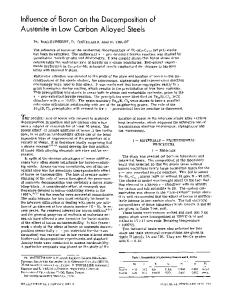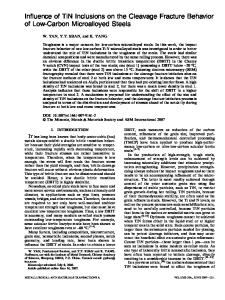The influence of niobium supersaturation in austenite on the static recrystallization behavior of low carbon microalloye
- PDF / 1,866,691 Bytes
- 10 Pages / 594 x 774 pts Page_size
- 68 Downloads / 290 Views
I.
INTRODUCTION
THE thermomechanical processing of microalloyed steel has been employed for some time in the production of plate and sheet material in order to optimize properties such as strength and impact toughness.E~-61More recentlyy ,81 this technology has also been applied to the bar and forging industry with considerable success. The central feature of thermomechanically processed steel is the ultrafine grain size in the final product. This fine grain size is known to cause both high strength and high resistance to brittle fracture by cleavage. While achieving high strength in structural steel is rather straightforward and well understood, achieving fine grain size is a more complex task related to the synergy which exists between the composition of the steel and its processing. It has been shown that the final grain size in pearlite-reduced steels is controlled by the metallurgical condition and transformation temperature of the parent austenite.L9,~~The metallurgical condition of the austenite is comprised of its grain size, composition, and crystalline defects, while the transformation temperature is controlled by the composition and defect structure of the austenite, as well as the cooling rate33J The range in behavior of austenite during hot deformation is exhibited schematically in Figure 1. This figure shows the influence of both deformation temperature (T~) and amount of strain on the microstructure of statically recrystallized austenite. It can be observed from Figure 1 that for constant deformation variables such as strain, strain rate, and interpass holding time, the austenite microstructure will be completely recrystallized at high deformation temperaE.J. PALMIERE, Assistant Professor, C.I. GARCIA, Associate Research Professor, and A.J. DeARDO, Professor, are with the Department of Materials Science and Engineering, University of Pittsburgh, Pittsburgh, PA 15261. Manuscript submitted October 1, 1993. METALLURGICALAND MATERIALSTRANSACTIONS A
tures (i.e., when T > T95p~t)- Multipass hot deformation sequences which end in this regime and where there is a pre-existing pinning force to suppress grain coarsening are entitled recrystallization controlled rolling (RCR) practices. Hence, the distinguishing feature of RCR processing is having a pre-existing pinning force (precipitate or solute) that is small enough to allow for static recrystallization to occur but large enough to suppress grain coarsening. As the deformation temperature is decreased (T95pc, > T > T~p~,) such that the progress of recrystallization becomes increasingly difficult, a partially recrystallized microstructure is observed. This microstructure is often referred to as being duplex because of a nonuniform grain size. Finally, a completely unrecrystallized microstructure is present when deformation occurs below the recrystaUization-stop temperature of austenite, T ~ (i.e., when T _< T5 pc,). Multipass hot deformation sequences which occur largely in this regime are entitled conventional controlled rolling (CCR) practices. For a fi
Data Loading...











